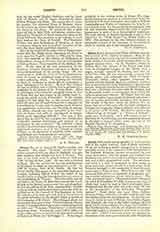
Dicuil
Irish monk and geographer, b. in the second half of the eighth century; date of death unknown

Dicuil, Irish monk and geographer, b. in the second half of the eighth century; date of death unknown. Of his life nothing is known except that he belonged probably to one of the numerous Irish monasteries of the Frankish Kingdom, became acquainted, by personal observation, with the islands near England and Scotland, and wrote between 814 and 816 an astronomical, and in 825 a geographical, work. The astronomical work is a sort of computus in four books, in prose and verse, preserved only in a manuscript which formerly belonged to the monastery of Saint-Amand, and is now at Valenciennes. More famous is the “De mensura Orbis terra”, a summary of geography, giving concise information about various lands. This work was based upon a “Mensuratio orbis” prepared by order of Theodosius II (435), a manuscript copy of which had found its way to the Carlovingian court. Godescalc had already made use of this copy (781-83) in the composition of his celebrated “Evangelistarium”. Dicuil draws also upon Pliny, Solinus, Orosius, Isidore of Seville, and other authors, and adds the results of his own investigations. In the nine sections he treats in turn of Europe, Asia, Africa, Egypt, and Ethiopia, the area of the earth’s surface, the five great rivers, certain islands, the length and breadth of the Tyrrhenian Sea, and the six (highest) mountains. Although mainly a compilation, this work is not with-out value. Dicuil is our only source for detailed information of the surveys carried out under Theodosius H; his quotations, generally exact, are of service for the textual criticism of the authors mentioned; of great interest, too, are the few reports which he got from the travellers of his time; as, for instance, from the monk Fidelis who (762?) journeyed along the canal then still existing, between the Nile and the Red Sea; and from clerics who had lived in Iceland six months. The manuscript was known to Welser, Isaac Vossius, Salmasius, Hardouin, and Schopflin; it first appeared in print under the title: “Dicuili Liber de mensura orbis terra ex duobus codd. mss. bibliothecae imperialis nunc primum in lucem editus a Car. Athan. Walckenaer” (Paris, 1807). The latest and best edition is that of G. ‘Parthey (Berlin, 1870).
OTTO HARTIG

